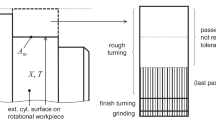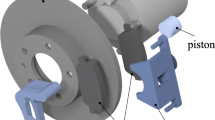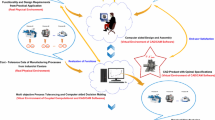Abstract
Tolerance transfer techniques are used extensively for allocation of tolerances for each machining operation in the process sequence, and hence are used to coordinate the process planning and the design activities in the evolution of a new product. This paper deals with an extended approach to allocate process tolerances based on a tree topology called technologically and topologically related surfaces (TTRS) and its subsequent extension to cost optimization. The benefit of this approach is that equations are generated explicitly with regard to tolerance transfer. These have been exploited by implementing the cost function in the generated explicit equations and subsequent optimization. The TTRS approach has been extended which scores over the limitations of some of the already existing techniques in that, it is optimal with respect to two factors namely, cost of producing the required tolerances, as also the process capability of the machines involved in producing the part. This technique has been proved practically feasible as it has been implemented in an industry. To enable a better view of the advantages of the approach, a comparative study with the existing techniques has been carried out in addition to a simulation using the Monte Carlo method.
Similar content being viewed by others
Abbreviations
- TTRS:
-
Technologically and topologically related surfaces
- Cost function:
-
\(C = A + B/T^{k} \)
- A:
-
Fixed cost include setup cost, tooling, material cost etc.
- B:
-
Cost of producing a single component dimension to a specified tolerance and includes the charge rate of the machine
- T:
-
Specified tolerance in mm
- k:
-
Sensitivity of the process cost to changes in tolerance specifications
- C:
-
Total cost of producing a single component dimension to a specified tolerance
- MGDE:
-
Minimum geometrical datum elements
- TTRS 1, TTRS 2, .... etc.:
-
Design specification TTRS
- S1, S2, S3,.... etc.:
-
Finished surfaces
- S1′, S2′, ..... , S1″,S2″,.... etc.:
-
Surfaces formed in intermediate machining operations and the final operations are yet to be performed
- TTRS1′, TTRS2′.... etc.:
-
Process plan related TTRS
- IS:
-
Indian standards
- TB.P :
-
Blue print tolerance
- Ti :
-
Tolerance of the ‘ith’ dimension
- Ai :
-
Fixed cost for the ‘ith’ dimension
- Bi :
-
Value of B for the ‘ith’ dimension
- n:
-
Number of dimensions
- λ:
-
Lagrangian multiplier
- B/P:
-
Blueprint
References
Desrochers A (2003) A CAD/CAM representation model applied to tolerance transfer methods. Trans ASME-J Mech Des 125:14–22
Ngoi BKA, Ong JM (1999) A complete tolerance charting system in assembly. Int J Prod Res 37(11):2477–2498
Chase KW (1999) Tolerance allocation methods for designers. ADCATS ReportNo.99–6
Khalil W, Besnard S, Lemoine P (2000) Comparison study of the geometric parameters calibration methods. Int J Robot Automat 15:56–67
Kalsi M, Hacker K, Lewis K (2001) A comprehensive robust design approach for decision trade - offs in complex systems design. ASME J Mech Des 121:1–10
Parkinson DB (2000) The application of a robust design method to tolerancing. ASME J Mech Des 22:149–154
Rajagopalan S, Cutkosky M (2003) Error analysis for the in-situ fabrication of mechanisms. ASME J Mech Des 125:809–822
Zhu J, Ting KL (2001) Performance distribution analysis and robust design. ASME J Mech Des 123:11–17
Hu SJ, Webbink R, Lee J, Long Y (2003) Robustness evaluation for compliant assembly systems. ASME J Mech Des 125:262–267
Gunasekaran K (2004) Study of tolerance-cost relationships for tolerance analysis and synthesis of precision assemblies. Dissertation, PSG College of Technology, Coimbatore, INDIA
Ngoi BKA, Fang SL (1994) Computer-aided tolerance charting. Int J Prod Res 32(8):1939–1954
Ngoi BKA, Ong CT (1993) A complete tolerance charting system. Int J Prod Res 31:453–469
Irani SA, Mittal RO, Lehtihet EA (1989) Tolerance chart optimization. Int J Prod Res 27(9):1531–1552
Wade OR (1967) Tolerance control in design and manufacturing. Industrial Press, New York, pp87–98
CMTI, Bangalore (2000) Machine tool design hand book. Tata McGraw Hill, New Delhi
Tseng Y-J, Kung H-W (1999) Evaluation of alternative tolerance allocations for multiple machining sequences with geometric tolerances. Int J Prod Res 37(17):3883–3900
Sanjeev Kumar SV (2004) Compatibility of the TTRS representation model with traditional tolerance transfer techniques. Dissertation, PSG College of Technology, Coimbatore, India
Author information
Authors and Affiliations
Corresponding author
Rights and permissions
About this article
Cite this article
Kumaravel, P., Anand, S., Ullas, U. et al. Cost optimization of process tolerance allocation-a tree based approach. Int J Adv Manuf Technol 34, 703–713 (2007). https://doi.org/10.1007/s00170-006-0641-0
Received:
Accepted:
Published:
Issue Date:
DOI: https://doi.org/10.1007/s00170-006-0641-0




